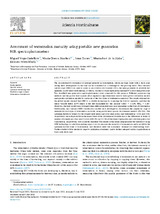Mostrar el registro sencillo del ítem
Assessment of watermelon maturity using portable new generation NIR spectrophotometers
| dc.contributor.author | Vega-Castellote, Miguel | |
| dc.contributor.author | Sánchez, María-Teresa | |
| dc.contributor.author | Torres, Irina | |
| dc.contributor.author | De la Haba, María-José | |
| dc.contributor.author | Pérez-Marín, D.C. | |
| dc.date.accessioned | 2024-02-06T17:22:40Z | |
| dc.date.available | 2024-02-06T17:22:40Z | |
| dc.date.issued | 2022 | |
| dc.identifier.uri | http://hdl.handle.net/10396/27186 | |
| dc.description.abstract | The non-destructive evaluation of internal maturity in watermelons, which are large fruits with a thick rind, during their development on the vine can be considered as a challenge for the growing sector. Near infrared spectroscopy (NIRS) was used to assess in situ soluble solid content (SSC), the main parameter to establish full maturity, in 249 intact watermelons, of which, 152 had a striped light green rind and 97 a solid dark green rind. Two handheld new generation spectrophotometers were compared for this purpose. Different pre-processing methods and the partial least squares (PLS) regression algorithm were used to build global calibration models and specific calibration models for each one of the two types of watermelon analysed. The results obtained for the global models showed that NIRS is a suitable technology for screening the fruit for maturity, and that the linear variable filters (LVF) sensor is the best equipment for this purpose (SECV = 1.02%; RPDp = 1.36). Moreover, the best results were obtained when different models were used depending on the type of watermelon. Additionally, near infrared (NIR) classification models were developed to discriminate the samples by stage of maturity for each type of watermelon available, using partial least squares discriminant analysis (PLS-DA). The optimum threshold values for the striped light green and solid dark green rind watermelons (0.82 and 0.65, respectively) were displaced from the mean value of the discriminant variable due to the differences in terms of number of samples per class used. A total of 66.4% and 82.2% of the striped light green and solid dark green rind watermelons, respectively, were correctly classified. The results of this study demonstrated the viability of using NIRS technology as a decision-making support tool to measure the maturity of watermelons and to establish the optimum harvest time of watermelons and therefore meet the consumers’ demand for sweet-tasting fruits. Further studies will be needed to improve calibration robustness, and to further interpret outdoor applications in fruits with thick rind. | es_ES |
| dc.format.mimetype | application/pdf | es_ES |
| dc.language.iso | eng | es_ES |
| dc.publisher | Elsevier | es_ES |
| dc.rights | https://creativecommons.org/licenses/by-nc-nd/4.0/ | es_ES |
| dc.source | Vega-Castellote, M., Sánchez, M., Torres, I., De La Haba, M., & Pérez‐Marín, D. (2022). Assessment of watermelon maturity using portable new generation NIR spectrophotometers. Scientia Horticulturae, 304, 111328. https://doi.org/10.1016/j.scienta.2022.111328 | |
| dc.subject | In situ analysis | es_ES |
| dc.subject | Spectral sensors | |
| dc.subject | Optimum harvesting time | |
| dc.subject | Prediction sugar content | |
| dc.subject | Watermelon classification | |
| dc.title | Assessment of watermelon maturity using portable new generation NIR spectrophotometers | es_ES |
| dc.type | info:eu-repo/semantics/article | es_ES |
| dc.relation.publisherversion | https://doi.org/10.1016/j.scienta.2022.111328 | |
| dc.rights.accessRights | info:eu-repo/semantics/openAccess | es_ES |

